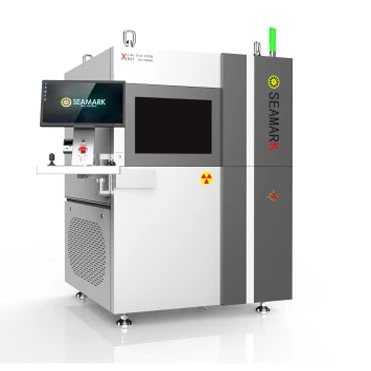A tomografia computadorizada de raios-X é a tecnologia mais avançada para medição 3D, controle de qualidade e não destrutiva-tirando várias imagens de vários ângulos e convertendo as imagens em escala de cinza em nuvens de pontos tridimensionais.
A tomografia computadorizada industrial é amplamente utilizada na inspeção de embalagens de semicondutores e na conexão interna, vários materiais, como componentes eletrônicos, inspeção de fundição.
Através da tecnologia de tomografia computadorizada de raios-X, podemos verificar com rapidez e precisão o detalhe dos componentes e amostras; É providrs a melhor solução para controlar a qualidade da produção;

Alta resolução: a fonte de raios-X de microfoco produz um feixe focalizado, permitindo imagens de alta resolução e a capacidade de detectar detalhes finos e pequenos defeitos em objetos.
Teste não destrutivo: esta técnica não é destrutiva, o que significa que permite uma inspeção completa sem danificar o objeto. Isso é particularmente valioso para fins de controle de qualidade e pesquisa.
Variedade de materiais: Os scanners de raios-X Microfocus podem ser usados para inspecionar uma ampla gama de materiais, incluindo metais, plásticos, cerâmicas, compostos e muito mais.
Precisão e precisão: as imagens 3D fornecem informações precisas sobre a estrutura interna, dimensões e defeitos potenciais do objeto.
Dissecção virtual: os engenheiros podem virtualmente "dissecar" o objeto para explorar suas características internas e identificar problemas potenciais sem desmontá-lo fisicamente.
No geral, os scanners 3D/CT de raio-X de microfoco são ferramentas valiosas em setores como aeroespacial, automotivo, eletrônica e manufatura, onde a inspeção precisa e não destrutiva de componentes complexos é essencial.
Geração de Raios-X: O scanner emprega um tubo de raios-X para gerar um feixe de raios-X focalizado. Este feixe é muito menor e mais preciso do que aqueles usados em sistemas tradicionais de raios-X.
Projeção de Raio-X: O objeto em exame é colocado entre a fonte de raios-X e um detector de tela plana. O feixe de raios-X passa pelo objeto e o detector registra os raios-X que emergem do outro lado. Diferentes materiais dentro do objeto absorvem raios-X em vários graus, criando níveis variados de intensidade no detector.
Coleção de rotação e projeção: para criar uma imagem 3D, o objeto é montado em um palco giratório. O estágio gira o objeto em pequenos incrementos, enquanto as projeções de raios-X são coletadas de vários ângulos. Esta rotação captura uma série de imagens de raios-X 2D, cada uma mostrando uma visão transversal diferente do objeto.
Análise de atenuação: As projeções de raios-X 2D coletadas retêm informações sobre a estrutura interna do objeto. Áreas com maior densidade ou espessura absorvem mais raios-X, resultando em menor intensidade no detector. O software analisa essas variações de intensidade para deduzir a composição e estrutura interna do objeto.
Reconstrução: Algoritmos avançados são empregados para processar as imagens 2D coletadas. Esses algoritmos usam os dados de atenuação de diferentes ângulos para reconstruir uma representação 3D detalhada do interior do objeto. Este processo é análogo à montagem de um quebra-cabeça 3D a partir de suas peças individuais.
Visualização e análise: A imagem 3D gerada pode ser visualizada e manipulada em um computador. Engenheiros e inspetores podem examinar as características internas do objeto de várias perspectivas e dissecá-lo virtualmente. Isso ajuda na identificação de defeitos, irregularidades ou complexidades estruturais que podem não ser aparentes externamente.
Resolução e precisão: os sistemas de raios-X Microfocus oferecem alta resolução, permitindo a detecção de pequenos defeitos ou estruturas finas dentro do objeto. Esse nível de detalhe é vital para setores onde a precisão e a precisão são fundamentais.
Teste não destrutivo: uma das vantagens mais cruciais dessa tecnologia é que ela permite uma inspeção abrangente sem danificar o objeto. Isto é especialmente valioso para componentes frágeis ou caros.